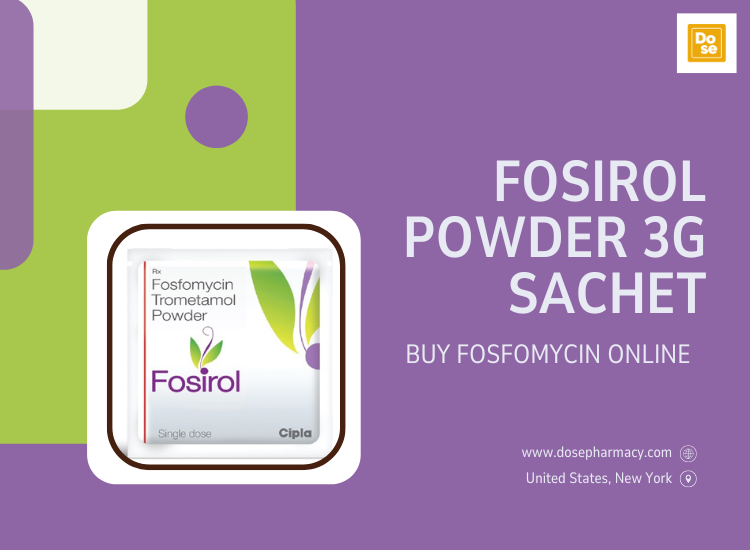Is Fosfomycin a Strong Antibiotic?
-

Fosfomycin 3gm Sachet is an antibiotic that has gained attention for its effectiveness in treating a range of bacterial infections, particularly urinary tract infections (UTIs). Despite its relatively niche use compared to more commonly known antibiotics, fosfomycin plays a crucial role in modern medicine. This article explores fosfomycin's mechanism of action, its strengths, areas of application, and how it compares to other antibiotics.
What is Fosfomycin?
Fosfomycin is a broad-spectrum antibiotic that was first discovered in the 1960s. Its structure and mechanism make it unique among antibiotics. It is particularly effective against Gram-positive and Gram-negative bacteria, including some drug-resistant strains, making it a valuable tool in fighting bacterial infections.This antibiotic is commonly available in an oral form as a single-dose sachet for treating uncomplicated urinary tract infections (UTIs) caused by bacteria such as Escherichia coli and Enterococcus faecalis. It is also available in intravenous forms for more severe infections.
How Does Fosfomycin Work?
Fosfomycin targets the bacterial cell wall synthesis, a fundamental process for bacterial survival.Inhibition of Enzyme UDP-N-acetylglucosamine Enolpyruvyl Transferase (MurA):
Fosfomycin binds to the enzyme MurA, which is essential for the early stages of bacterial cell wall formation. By doing so, it prevents the bacteria from building and maintaining their cell walls, leading to their destruction.Broad-Spectrum Activity:
Its mechanism is effective against a variety of bacterial species, including those resistant to other antibiotics.Minimal Resistance Development:
Although resistance to fosfomycin exists, it is less frequent compared to other antibiotics, thanks to its unique mode of action.Is Fosfomycin a Strong Antibiotic?
The term “strong” in the context of antibiotics refers to effectiveness against bacteria, ability to treat resistant strains, and the breadth of its spectrum. Fosfomycin checks many of these boxes, particularly in specific scenarios:1. Effective Against Resistant Strains
Fosfomycin has shown effectiveness against multidrug-resistant (MDR) bacteria, including extended-spectrum beta-lactamase (ESBL)-producing E. coli and carbapenem-resistant Enterobacteriaceae. This makes it a critical option in an era of rising antibiotic resistance.2. Broad-Spectrum Antibiotic
Fosfomycin’s ability to target both Gram-positive and Gram-negative bacteria, including common UTI pathogens, underscores its strength.3. Single-Dose Efficacy
For uncomplicated UTIs, a single oral dose of fosfomycin can be highly effective. This convenience enhances patient compliance and reduces the risk of incomplete treatment.4. Low Risk of Cross-Resistance
Unlike some other antibiotics, fosfomycin has minimal cross-resistance with other drug classes, making it a viable option for patients with resistant infections.However, the strength of fosfomycin is context-dependent. While it is highly effective for certain infections, it may not be the best choice for others.
Applications of Fosfomycin
Fosfomycin is used to treat a variety of bacterial infections, with its most common applications being:1. Urinary Tract Infections (UTIs)
Uncomplicated UTIs: Fosfomycin is FDA-approved for treating uncomplicated UTIs caused by E. coli and Enterococcus faecalis.
Complicated UTIs: Intravenous fosfomycin is sometimes used in combination with other antibiotics for complicated or recurrent UTIs.
2. Multidrug-Resistant Infections
Fosfomycin is a valuable treatment option for infections caused by MDR bacteria, including carbapenem-resistant strains, where other antibiotics may fail.3. Respiratory and Bone Infections
While less common, intravenous fosfomycin can be used to treat severe respiratory tract infections or osteomyelitis caused by susceptible bacteria.Comparing Fosfomycin to Other Antibiotics
1. Spectrum of Activity
Fosfomycin’s broad-spectrum action makes it comparable to other strong antibiotics like carbapenems. However, its specific mechanism allows it to target bacteria resistant to these antibiotics.2. Ease of Use
The single-dose regimen for uncomplicated UTIs sets fosfomycin apart from many antibiotics that require multiple doses over several days.3. Resistance Patterns
While fosfomycin has a low resistance rate compared to other antibiotics, improper use can still lead to resistance development. Careful prescription practices are essential to maintain its effectiveness.4. Tolerability
Fosfomycin is generally well-tolerated, with fewer gastrointestinal side effects than some other antibiotics.Advantages of Fosfomycin
Convenience: Single-dose oral therapy for UTIs simplifies treatment.
Broad-Spectrum: Effective against a wide range of bacteria.
Safe Profile: Low systemic absorption reduces the risk of adverse effects.
Combating Resistance: Effective against resistant bacteria, including ESBL-producing strains.
Potential Drawbacks of Fosfomycin
Limited Applications: While effective for UTIs and some resistant infections, it is not a first-line treatment for all bacterial infections.
Resistance Development: Overuse or misuse could lead to increased resistance.
High Cost in Some Regions: Fosfomycin can be expensive compared to other antibiotics.
Side Effects and Safety
Fosfomycin is generally well-tolerated, but some individuals may experience mild side effects, such as:Nausea
Diarrhea
Headache
Abdominal pain
Severe side effects are rare but may include allergic reactions or liver enzyme abnormalities. Pregnant or breastfeeding women should consult a healthcare provider before use.Who Should Avoid Fosfomycin?
Fosfomycin is not suitable for everyone. Individuals with the following conditions should exercise caution:Allergies to Fosfomycin: Those with known allergies should avoid the drug.
Severe Kidney Disease: Dosage adjustments may be required.
Inappropriate Infections: Fosfomycin is ineffective for certain infections, such as bloodstream infections, without combination therapy.
Fosfomycin and the Rise of Antibiotic Resistance
Antibiotic resistance is a growing concern globally, and fosfomycin is no exception. To preserve its effectiveness, it’s essential to use fosfomycin judiciously:Avoid Overuse: Only use fosfomycin when prescribed by a healthcare provider.
Complete the Course: Ensure the full course of treatment is taken, even if symptoms improve.
Prevent Infections: Good hygiene and proper food handling can reduce the risk of infections requiring antibiotics.
Fosfomycin is undeniably a strong antibiotic in specific contexts. Its effectiveness against multidrug-resistant bacteria and convenience for treating uncomplicated UTIs make it a critical tool in modern medicine. However, its strength is not universal, as it is most effective for targeted infections.When used responsibly under the guidance of a healthcare provider, fosfomycin can deliver remarkable results, particularly in an era of increasing antibiotic resistance. By understanding its uses, benefits, and limitations, patients and clinicians can harness its potential while safeguarding its effectiveness for future generations.